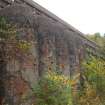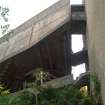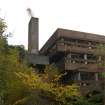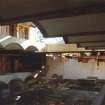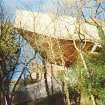Notice
Following a review of the Buildings at Risk Register we have paused the Register while we consider options for its future.
The website will remain accessible and searchable during this time, but it will not be updated and we’re not accepting nominations for additions to the Register. If you need to contact us about the BARR please email hmenquiries@hes.scot
Read the review report here and you can find out more about why we have paused the BARR on our news centre.
St Peter's College (Former), Carman Hill
Ordnance Survey licence number AC0000807262. All rights reserved. © Copyright and database right 2024. Public Sector Viewing Terms
Useful Links
- Canmore:
- CARDROSS, ST PETER'S COLLEGE
- Historic Scotland:
- HS Reference No 6464
General Details and Location
Category
AT RISK
Name of Building
St Peter's College (Former)
Other Name(s)
Cardross Seminary (Former)
Address
Carman Hill
Locality
Postcode
Planning Authority
Divisional Area
Reference No
1483
Listing Category
A
OS Grid Ref
NS 35304 78404
Location Type
Rural
HS Reference No
6464
Description
Seminary buildings, originally linked to Kilmahew House (now demolished) consisting of a large main block, 4-storey over a partly raised basement accommodating chapel, refectory and study bedrooms; 2-storey over raised basement, lecture theatre/library block joined at right angles to main block; single storey kitchen wing (now partly demolished) linking the main block to Kilmahew House; 2-storey convent wing formerly adjoined to Kilmahew House to N. Concrete slab and column construction, brown pebble facings to precast concrete slab cladding; interior of main block with non-structural vaulted ceiling of metal lath and plaster.
St Peter's seminary was commissioned in 1958 by the Archbishop of Glasgow. Now redundant it has been systematically vandalised and is now reduced to a ruinous skeleton.
Designed by innovative architects, Metzstein and McMillan (who ran the Gillespie, Kidd and Coia architectural practice after the war (overseen by Jack Coia) it is hailed as one of the finest modern buildings of the day and was recognised as such when it was awarded the prestigious RIBA Architecture award in 1967.
Influenced by the architecture of Le Corbusier and in particular his monastery of La Tourette, they took the traditional monastic plan and reshaped it to form a totally modern idiom in terms of planning, of interrelated spaces which are expressed on the exterior by the change of form and materials and with technical virtuousity they achieved a complex of buildings of amazing effects and sculptural quality. Kilmahew House was demolished in 1995 following fire damage. (Historic Scotland)
St Peter's seminary was commissioned in 1958 by the Archbishop of Glasgow. Now redundant it has been systematically vandalised and is now reduced to a ruinous skeleton.
Designed by innovative architects, Metzstein and McMillan (who ran the Gillespie, Kidd and Coia architectural practice after the war (overseen by Jack Coia) it is hailed as one of the finest modern buildings of the day and was recognised as such when it was awarded the prestigious RIBA Architecture award in 1967.
Influenced by the architecture of Le Corbusier and in particular his monastery of La Tourette, they took the traditional monastic plan and reshaped it to form a totally modern idiom in terms of planning, of interrelated spaces which are expressed on the exterior by the change of form and materials and with technical virtuousity they achieved a complex of buildings of amazing effects and sculptural quality. Kilmahew House was demolished in 1995 following fire damage. (Historic Scotland)
Building Dates
1966
Architects
Isi Metzstein, John Cowell and Andrew MacMillan of Gillespie, Kidd and Coia
Category of Risk and Development History
Condition
Ruinous
Category of Risk
High
Exemptions to State of Risk
Field Visits
February 1990, 15/10/2008, 09/12/2009, 01/02/1990
Development History
1978: The college is vacated and some of the surrounding land sold to Cardross Golf Club. The seminary buildings are unsuccessfully offered to the police as a training college and then to hotel developers. Applications to sell the land for building were blocked as contrary to green belt policy. Kilmahew House subsequently reopened as a drug rehabilitation centre, but was later closed over fears of vandalism. February 1990: External inspection reveals the college to be vacant and is disrepair. Winter 1990: The newsletter of the Glasgow Institute of Architects reports that the Archdiocese of Glasgow is seeking permissions to demolish the 1966 buildings. The classroom wing has suffered water ingress, whilst the copper roof has been stripped in places. The globe lights hanging in the upper lecture rooms are fillled with water and furnishings are now tarnished with mould. However, the buildings remain structurally sound. The adjacent Kilmahew House is well-maintained. 23 February 1992: Press reports note that the Archdiocese has withdrawn security from the site, which is now beset by vandalism although security gates are to be erected. Currently listed within the curtilage of Kilmahew House, Historic Scotland is considering listing the seminary separately. The Walker Group has been commissioned by the Archdiocese to access the development potential of the site. 27 March 1992: The Glasgow Herald reports note that restoration is estimated at £5 million. The Walker Group has invited all interested parties to meet and discuss the future of the site. Security gates have now been erected. The Scotsman repeats the story. July 1992: A Repairs Notice is served. 4 September 1992: The Helensburgh Advertiser reports that the seminary building has been A-listed. 11 September 1992: The Lennox Herald repeats the story. 14 September 1992: The Glasgow Herald repeats the story. 16 September 1992: Press reports note that the buildings remain for sale. The owners are asking local residents to help counter vandalism. 28 September 1992: The Herald reports on the condition of the seminary. 23 October 1992: The press carries a letter from Docomomo, an international watchdog for the protection of outstanding 20th century buildings, decrying the current condition of the seminary. 25 June 1993: Press reports note that the Archdiocese has asked developers Classical House to join talks on the future of the site. 3 November 1993: The Dumbarton Reporter notes that the Archdiocese has submitted 2 applications for the redevelopment of the site. The first would see the seminary building converted into 6 townhouses, with the teaching block forming 1 house. 60 new houses would also be built on green belt land. The second scheme would see all the building retained and secured for future use by a public body, possibly incorporating a visitors' centre. 24 new houses would be built. Both schemes include the creation of a country park. Classical House is acting as partner. 5 November 1993: The Helensburgh Advertiser and Lennox Herald repeat the story. 3 December 1993: Press reports note that the plans are opposed by many locals. As part of the first scheme, Kilmahew House would be demolished save for the south eastern tower. 20 December 1993: The Herald reports that the plans are opposed by the Cardross Community Council. The Helensburgh and District Civic Society has lodged a formal objection. 30 March 1994: The Dumbarton Reporter notes that planning officials have recommended refusal of all applications, save for the partial demolition of Kilmahew House. 1 April 1994: The Lennox Herald notes that the applications are viewed as contrary to green belt policy and were opposed by Scottish Natural Heritage. Dunbartonshire Enterprise has expressed a willingness to fund condition surveys and marketability reports for the Scottish Historic Buildings Trust. The Helensburgh Advertiser repeats the story. 22 April 1994: The Lennox Herald reports that SHBT is interested in acquiring the seminary under conditions offered in the second scheme, whereby new owners would be given £75,000 to fund maintenace and security. It is exploring conversion into a conference centre, estimated at £3 million. 27 April 1994: The Dumbarton Reporter notes that the Planning and Development Committee has supported the partial demolition of Kilmahew House and alterations to the seminary, but has rejected housing developments on the site. 29 April 1994: The Helensburgh Advertiser repeats the story. 30 April 1994: The Herald reports that the Archdiocese may appeal the decision. 25 May 1994: The Dumbarton Reporter notes that Kilmahew House has been ravaged by fire. The seminary buildings remain largely unaffected. July 1994: EDAW CR Planning of Glasgow is commissioned by Dunbartonshire Enterprise to undertake a market assessment of potential new uses. 2 September 1994: The Lennox Herald reports that permissions are sought for the demolition of Kilmahew House. Local planners are recommending approval, though SCT has objected. The house is subsequently demolished in 1995. 5 November 1994: The Herald carries a feature on the seminary. 1 June 1995: The Helensburgh Advertiser notes that Classical House is seeking permission to build 22 houses at the site, with SHBT becoming custodians of the present structures and a £50,000 estate management fund. An area of land will be given over to the Council for use as a country park, whilst the remaining land will be given over to the Strathclyde Greenbelt Company, who will be responsible for maintaining the woodland. Local planners are recommending approval, although the plans are not supported by Strathclyde Reginoal Council. 2 June 1995: The Lennox Herald repeats the story. 7 June 1995: The Dumbarton Reporter notes that Councillors are minded to approval the application. 8 June 1995: The Helensburgh Advertiser repeats the story. 9 June 1995: The Lennox Herald repeats the story. 6 June 1996: The Helensbrugh Advertiser reports that the application was refused, following objections from Strathclyde Regional Council. The decision went to appeal, but has been upheld. 13 June 1996: The Helensburgh Advertiser reports that a local Councillor has criticised the decision. January 1997: Local planners report that further discussions are taking place between the Council and the Archdiocese with a view to submitting an amended planning application. 22 May 1997: The Helensburgh Advertiser reports on the plight of the college. 10 September 1998: The Helensburgh Advertiser reports that new plans by Classical House would see the seminary stabilised and 33 houses built in the walled garden. The plans are supported by the Cardross Community Council. 4 March 1999: The Helensburgh Advertiser reports that an application has gone before Councillors. The sale of the 25th house would trigger a payment of £100,000 to the local authority for the maintenance of the proposed country park. The seminary buildinfs would be mothballed and gifted to the council, to be managed by a specifically established trust. Local planners are recommending approval. 5 March 1999: The Lennox Herald repeats the story. 7 March 1999: The Sunday Express reports that DOCOMOMO has criticised the plans and has named the seminary as one of the top ten postwar buildings in the country. 8 April 1999: The Helensburgh Advertiser reports that the plans are opposed by environmental campaigners and members of the adjacent Cardross Golf Club. 16 April 1999: The Lennox Herald reports that the plans have been approved with conditions. 24 April 1999: The Helensburgh Advertiser carries criticism of the decision. 7 October 1999: The Helensburgh Advertiser reports on the decision to go to a Public Inquiry. 11 November 1999: The Helensburgh Advertiser reports that Historic Scotland has withdrawn support for the scheme. 27 January 2000: The Helensburgh Advertiser reports on the Public Inquiry. 28 January 2000: The Lennox Herald repeats the story. August 2000: The decision is called in for consideration by the Secretary of State and is subsequently overturned. January 2003: Classical House reports that it is to undertake a further marketing appraisal. 13 February 2003: The Clydebank Post and the Helensburgh Advertiser report on the college's inclusion on the Buildings at Risk Register. 25 April 2003: The Lennox Herald reports that the Archdiocese is exploring the establishment of a trust to repair the roof and maintain the building. 2 May 2003: The Clyde Weekly News repeats the story. 7 February 2004: The Herald carries a feature on the seminary in its magazine. A Cardross Regeneration Trust has been established to engender debate on the building. 22 April 2004: The Helensburgh Advertiser reports on speculation that the college may feature in the second series of BBC's Restoration programme. 28 April 2004: The Dumbarton Reporter repeats the story. 12 May 2004: The Dumbarton and Vale of Leven Reporter notes the building's inclusion on the Buildings at Risk Register. 13 May 2004: The Helensburgh Advertiser repeats the story. 19 May 2004: The Dumbarton and Vale of Leven Reporter notes that the Archdiocese of Glasgow is to submit new plans to mothball the college and build 28 houses in the grounds. 21 May 2004: The Clyde Weekly News reports that the college will not feature on BBC's Restoration programme. 6 July 2004: The Herald reports that the Archdiocese now plans to build 28 homes in the grounds and use the resulting funds to stabilise the college. The Kilmahew Estate grounds will be restored and gifted to a local management company so that they can be opened up to the local community. 8 July 2004: The Helensburgh Advertiser repeats the story. 9 July 2004: The Catholic Observer repeats the story. 19 July 2004: The Glasgow Evening Times repeats the story. 23 July 2004: The Clyde Weekly News repeats the story. 18 November 2004: The Herald reports on criticism of the planning application, which would see much of the college stripped back and mothballed. The St Peter's Building Preservation Trust has withdrawn its support for the plans. 29 November 2004: The Herald carries letters and opinions on the proposals. 4 December 2004: The Herald carries comments on the proposals. 24 December 2004: The Lennox Herald reports that the plans have been formally lodged. October 2005: Clyde weekly News reports that the seminary has been awarded the title of Scotland's most influentuial modern building by Prospect Magazine. June 2007: avanti architects report that they have been appointed by the Archdiocese of Glasgow, with funding from Historic Scotland, to compile a Conservation Assessment and Cost Report. 13th July 2007: The Scotsman reports that the building has been added to a list of the world's most endangered buildings by the World Monument Fund, and a conservation plan has been commissioned. August 2007: The WMF's magazine Monumentum, highlights the plight of St.Peter's.
April 2008: A member of the public contacts SCT who visited the site recently and reported that there have been various attempts to set fire to the building but there is little combustible materials left.
September 2008: A member of the public contacts SCT to advise that the building is degrading further and further. Part of the top floor balcony has come loose with the concrete support broken making it moveable, eventually going to break off.
October 2008: External inspection finds the building in ruinous condition. The building has been subject to much vandalism, is unsecured and continues to deteriorate. The building appears structurally sound but all timber and glass elements have now been lost.
December 2008: The Herald reports on talks between the Archdiocese of Glasgow, Argyll and Bute Council and Urban Splash to draw up a development plan to save the building. The Archdiocese are reported as having signalled their readiness to transfer the building to Urban Splash for a nominal sum if they can raise sufficient funding and obtain the necessary planning permissions. The Lennox Herald repeats the story.
April 2009: The Herald reports that NVA environmental art company have been awarded with a grant of £45,000 to create a series of new art works for the site and are working with Urban Splash to aid the restoration process.
July 2009: A member of the public reports that on the 11th July, there was another arson attack on the College. The teaching block is now completely burnt out and the remains of the roof over the altar has caught fire and partly collapsed.
December 2009: External inspection finds the college remains at risk.
May 2011: BBC news website reports Public Arts Charity NVA has concluded missives with the Catholic Church for St Peter‘s Seminary. The article notes plans by NVA to stabilise parts of the structure and restore some interior spaces for cultural and educational use. NVA is noted as having secured £100,000 rom Creative Scotland‘s NLF towards the project, and the charity aims to raise £2m by 2013 to take the project forward.
December 2011: Urban Realm reports NVA has published a masterplan for the site completed by ERZ landscape architects and Avanti Architects. The masterplan is reported as outlining a 20 year plan of phased development to bring the buildings back into use, but also improve the surrounding Kilmahew Woods. The masterplan can be downloaded from the NVA website at www.nva.org.uk.
18 April 2012: Historic Scotland announces St Peter's has been awarded £500,000 from the Building Repair Grant scheme.
25 October 2012: External inspection finds no significant change from the previous site visit.
6 February 2013: Full Planning Permission and Listed Building Consent for change and use and alteration to form event space with consolidation of existing structure and access works have been lodged ref: 13/00094/LIB & 13/00093/PP.
5 December 2013: BBC News website reports the Heritage Lottery Fund have granted charity NVA £565,000 towards the development of plans to restore the former seminary into a visitor attraction. The article notes the charity aims to launch a public fundraising campaign in 2014 with a goal of £3.5m.
29 September 2014: A member of the public notes The Architects' Journal reported May 2014 NVA were seeking to appoint a design team to progress plans to restore and convert the site to a education and arts centre. The article goes on to note that with a design team in place work will commence towards the submission of a Round 2 application to the Heritage Lottery Fund.
9 March 2016: The Regeneration Capital Grant Fund 2016-17 has awarded the Redevelopment of St Peter's £650,000 towards the conversion of the site to a visitor attraction.
1 December 2016: NVA is aiming to commence a 2 year restoration/ conversion of the former seminary into programme in a public arts and performance space in 2017.
8 January 2019: Arts charity NVA is no longer pursuing the redevelopment of the site into a visitor attraction.
3 August 2020: Urban Realm website reports (27/7/2020) ownership of the site has been transferred to charitable body the Kilmahew Education Trust. The Trust is reported to be developing plans to re-use the site.
Availability
Current Availability
Not Available
Appointed Agents
Price
Occupancy
Vacant
Occupancy Type
N/A
Present/Former Uses
Building Uses Information:
Present Use 1: N/A Former Use 1: School/College/University
Present Use 2: N/A Former Use 2: N/A
Present Use 1: N/A Former Use 1: School/College/University
Present Use 2: N/A Former Use 2: N/A
Name of Owners
Kilmahew Education Trust
Type of Ownership
Charity/Trust
Information Services
Additional Contacts/Information Source
Bibliography
Deffenbaugh (2003); Walker and Sinclair (1992), p61; Watters (1997); Willis (1977), pp56-59; Architectural Heritage, (11) 2000, p77; Architects' Journal, 6 May 1964; Artwork, April/May 1989; Concrete Quarterly, January/March 1967; Country Life, 27 July 1967; Interior Design, August 1967; Newsletter of the Architectural Heritage Society of Scotland, Spring 1994, pp40-43; Prospect, September 1979, p15; The Clergy Review, March 1967.
Online Resources
Classification
Schools
Original Entry Date
20-FEB-90
Date of Last Edit
03/08/2020




